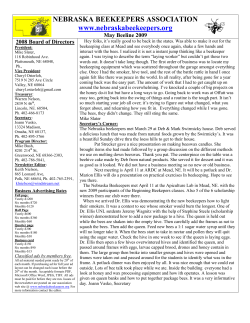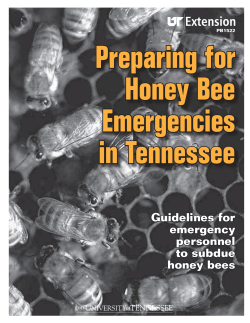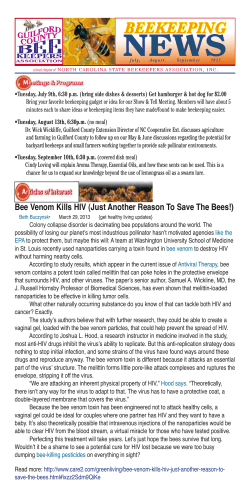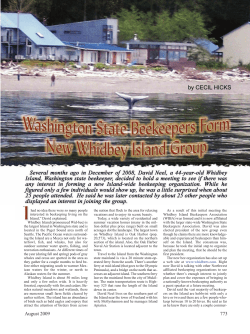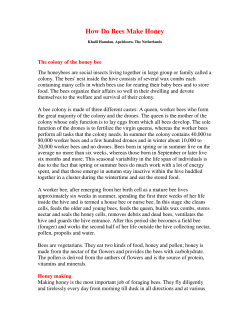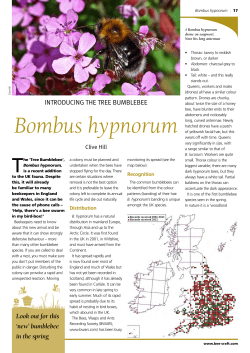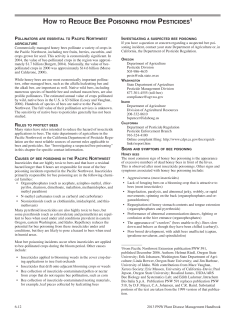
Pesticides and Native Pollinators: How to recognize and protect native bees
Pesticides and Native Pollinators: How to recognize and protect native bees Presented by Mace Vaughan Pollinator Program Director, The Xerces Society for Invertebrate Conservation Joint Pollinator Conservation Specialist, NRCS West Nat’l Tech Support Center Photo: Edward S. Ross What is the Xerces Society Th X The Xerces S Society i t An international non-profit non profit that works to protect wildlife and biodiversity through the conservation of invertebrates. Photo: © Edward Ross Xerces Conservation Methodology The Xerces Society: A Nationwide Pollinator Outreach and Education Organization Collaborating with scientists, government agencies, cooperative extension, conservation groups and farmers • Training and outreach • Technical publications • Applied research • Direct technical support to growers • Develop new conservation tools • Information for policymakers and media • Document at-risk pollinators pp to the USDA-NRCS • Technical support Photo: Eric Mader Talk Outline Talk Outline • Importance of native pollinators • Biology of native pollinators (esp. bees) • Recognizing native bees and their habitat • Reducing impacts off pesticides ti id Photo: Bruce Newhouse Part 1 1. The Importance of Pollinators © Bruce Newhouse Importance of Pollinators: Pollination Pollination o at o is s tthe e ttransfer a se o of pollen grains from the anther to stigma of the same or another flower. • Self-pollination: transfer within a flower or flowers of the same plant • Cross-pollination: transfer between plants Photo: Steve Javorek, Agriculture Canada Insect Pollinators: An Ecological Keystone More than 70 percent of flowering plants (˜ 240,000 sp.) require an insect to move pollen. Photo: Eric Mader Importance of Pollinators Pollinators provide an ecosystem service that enables plants to produce fruits and seeds. • 35% of crop production, production worldwide • Value of crops in U.S.: $18 to $27 billion • One in three mouthfuls of food and drink we consume Photo: USDA-ARS/Peggy Greb Importance of Pollinators Photo: Karen Ward, NPS © Marie Read • Fruits and seeds are a major part of the diet of about 25% of birds, and many mammals • Pollinators are food f wildlife for f © NRCS © Robert Parks © Marie Read Main Groups of Pollinators Photos: James Cane; Jeff Adams; Dana Ross; Bruce Newhouse Photos: Mace Vaughan, Bob Hammond, David Inouye, Bruce Newhouse Bees: The most important pollinators • Bees provide for their young • Bees actively collect and transport pollen • Bees exhibit flower constancy • Bees regularly reg larl forage in area aro around nd nest Photo: Edward S. Ross Honey Bees: Essential Non-Native Livestock • M Mostt crop pollination lli ti iis d done b by th the European honey bee. • This leaves us reliant on a single pollinator, one that is experiencing many problems. Photo: USDA-ARS/Scott Bauer Crop Pollination: Honey Bees in Decline Fewer e e honey o ey bees a available a ab e V Varroa mite it • 50% decline in managed hives since 1950 • Doubling of cropland requiring bee pollination • 70-100% 70 100% decline in feral colonies • 15% to 22% annual losses since the mid mid-19902 19902 Causes: Disease, pests, honey prices, and… Photo: USDA-ARS/Scott Bauer Honey Bees: Colony Collapse Disorder Fewer honey bees available • 2006-07: 31% losses • 2007-08: 2007 08: 36% losses • 2008-09: 29% losses • 2009-10: 34% losses Causes: Add Colony Collapse Disorder to the mix. Photo: USDA-ARS/Scott Bauer Possible Causes of Colony Collapse Disorder Colony Co o y Collapse Co apse Disorder so de • Disease/pathogen? • New viruses? • New strain of Nosema? • Pests? • Poor diet? • Insecticides? • Low genetic diversity? • Stress? Photo: USDA-ARS/Scott Bauer Possible Causes of Colony Collapse Disorder Colony Co o y Collapse Co apse Disorder: so de • Disease/pathogen? • Israeli Acute Paralysis Virus? • New strain of Nosema? • Pests? • Poor diet? • Insecticides? • Low genetic diversity? • Stress? • Not cell phones Photo: Charles Vorisek The Rising Cost of Commercial Pollination Honey bee colony rental rates for selected California crops crops, 1995–2005 1995–2005. The Rising Cost of Commercial Pollination 2007 Honey bee colony rental rates for selected California crops crops, 1995–2005 1995–2005. Plus almonds, 2006-2008 2006 2008 Crop Pollination: Important to diversify Fewer honey bees available • Important to diversify pollinators for production agriculture Photo: Bob Hammond, CO Coop Ext Crop Pollination: Important to diversify Fewer honey bees available • Important to strengthen habitat and pesticide protection for all b bees (h (honey and d native) ti ) Photo: USDA-NRCS Native Bee Diversity in Agriculture Photo: USDA-ARS Contribution of native bees to crop pollination: • 80+ bee species recorded visiting berry crops in New England • 100+ species documented in WI cranberries • 100+ species p visiting g apples pp in NY and PA • 50+ species visiting tomato, sunflower, or watermelon in California Native Bee Diversity in Agriculture Example: Blue orchard bee • 250 to 750 females/acre compared to 1 to 2.5 hives of honey bees •M Make k contact t t with ith anther th and d stigma on almost every visit • Active at low light levels and low temperatures • 33+ hours foraging in 5 days • 15+ hours by honey bees Bosch, J. and W. Kemp. 2001. How to Manage the Blue Orchard Bee as an Orchard Pollinator. Sustainable Agriculture Network. Beltsville, MD. 88 pp. . Photo: Eric Mader Native Bee Diversity in Agriculture Example: a pe C Cherry e y to tomatoes atoes When native bees were present, the production of Sungold cherry tomatoes almost tripled. tripled Greenleaf, S. S.,and C. Kremen. 2006. Wild bee species increase tomato production and respond differently to surrounding land use in Northern California. Biological Conservation 133:81-87. Photo © Burpee; Mace Vaughan Native Bee Diversity in Agriculture N ti bees Native b and d alfalfa lf lf • Honey bees learn to bypass the pollination mechanism • Most seed production by leafcutter and alkali bees • Wild bees trip over 80% of alfalfa flowers visited; leafcutter bees and honey bees trip only 25% Photo: Eric Mader Johanne Brunet and Christy M. Stewart, “Impact of Bee Species and Plant Density on Alfalfa Pollination and Potential for Gene Flow,” Psyche, vol. 2010, Article ID 201858, 7 pages, 2010. doi:10.1155/2010/201858 Step 1: Recognize pollinators and habitat Part 2. 2 Recognizing Native Bees Photo: Whitney Cranshaw, Colorado State University; bugwood.org Recognize Pollinators: Native bee diversity North America: 4,000 species OR/WA: 600-800 species? California: 1500 species p Photo: Mace Vaughan Bees Are Not Wasps Yellowjackets and other social wasps are the insects that generally sting people. Photo: James Cane Recognize Pollinators: Native bee diversity Photo: Stephen L. Buchmann Recognize Pollinators: Native bee diversity Honey bee (Apis mellifera) Cactus bee (Diadasia sp.) Bumble bee (Bombus edwardsii) Leafcutter bee (Megachile sp.) Photos: James Cane; Robert Parks; Edward S. Ross Recognize Pollinators: Native bee diversity Metallic sweat bee (Agapostemon sp.) Yellow-faced bee (Hylaeus sp.) Mason bee (Osmia sp.) Sweat bee (Halictus sp.) Photos: Bruce Newhouse; Edward S. Ross; Mace Vaughan; USDA-ARS/Jack Dykinga Recognize Pollinators: Native bee diversity Metallic sweat (Agapostemon sp.) Sunflower bee bee (Svastra sp.) Carpenter bee (Xylocopa sp.) Mason bee (Osmia sp.) Long-horned bee (Mellisodes sp.) Photos: Bob Hammond, Colorado State University Cooperative Extension Part 3 3. Ecology of Native Bees (recognizing their habitat) Photo: Rollin Coville Three Broad Groups of Native Bees Ground-Nesting Bees (solitary) Bumble Bees (social) ( ) Wood-Nesting Bees (solitary) Photos: Steve Javorek, Eric Mader, Elaine Evans Life Cycle of a Solitary Bee Mining bee (Andrena sp.): a year in its underground nest as egg, larva, and pupa before emerging to spend a few weeks as an adult adult. Photos: Dennis Briggs Ground-Nesting Solitary Bees • Roughly 70% of native b species bee i nestt underground • Resemble ant-nests from above ground • Nest chambers are lined with waxy glandular secretions, and can sometimes even resist flooding g • Very common bees • Conserve sandy soil, bare ground Photos: Eric Mader, Matthew Shepherd, Dennis Briggs Ground-Nesting Solitary Bees Numerous groundnesting crop pollinators • Andrena A d mining i i bees (apple, cherry, blueberry) • Squash bees (cucurbits) • Svastra (hybrid sunflower) Photo: Connie Stubbs Ground-Nesting Solitary Bees Ground-nesting G ou d est g ((~70%) 0%) Photo: Eric Mader Photo: Matthew Shepherd Source: Stephen, Bohart, and Torchio, 1967 Ground-Nesting Solitary Bees Ground Nests © Matthew Shepherd © Dennis Briggs © Matthew Shepherd © Steve Javorek, Agriculture Canada Ground-Nesting Solitary Bees Gro nd Nests Ground Photo: Bob Hammond, CO Coop Ext Wood-Nesting Bees Roughly g y 30% of native species p nest in hollow plant stems, or old beetle borer holes • Nest tunnel p partitions constructed of mud, leaf pieces, or sawdust • Artificially managed for some crops p © Edward Ross • Conserve snags, brush piles Photo: Matthew Shepherd Photo: Mike Carter Wood-Nesting Bees Hollow stem example: Cross-section of silk cocoons Pollen mass Egg Mud wall Larva Silk cocoons with dormant bees inside Pupa Adult Mud cap closure Wood-Nesting Bees N t cells Nest ll separated t d with ith mud d or leaf l f partitions titi Wood-Nesting Bees Managed tunnel nesting bees: • Mason bees (blue orchard bee) • Alfalfa leafcutter bee (non-native) Bumble Bees • 45 species in U.S. • Social colonies founded by a single queen • Colonies last only one season • Nest may contain 100-300 workers • Nests in abandoned rodent burrows or under lodged grasses • Conserve brush piles, un-mowed areas Photos:Eric Mader, Elaine Evans Life Cycle of a Bumble Bee Colony Bumble Bees: Excellent Crop Pollinators • Pollinators of red clover, clover tomato • More efficient than honey bees for blueberry blueberry, cranberry, melons, etc. • Active in cool and wet weather th Photos:, Eric Mader(Xerces Society), Steve Javorek (AgCanada) Bumble Bees Bumble u b e bees nest est in e existing st g ca cavities t es suc such as o old d rodent ode t holes, in overgrown areas or under brush piles. © Mace Vaughan © NRCS Lynn Betts Recognize Habitat: Foraging Needs • Drink nectar from any accessible flower • May be more particular about where they collect pollen • Some collect leaf pieces, i resin, i soil, il etc. t for nest construction Photo: Rollin Coville Recognize Habitat: Foraging Needs Photos: Matthew Shepherd; Berry Botanic Garden Photos: Elaine Haug NRCS, Matthew Shepherd; Mace Vaughan, Eric Mader, Jeff McMillan NRCS, Berry Botanic Garden Recognize Habitat: Foraging Needs Mace Vaughan, Xerces Society Part 4: Reducing Impacts of Pesticides to Native Bees Photo: Mace Vaughan, Xerces Society Risk Assessment: Native Bees vs. Honey Bees Pesticides Honey Bee Larva = Royal Jelly Current risk assessment protocols focus on honey bees. • Honey bees much larger than many native bees • Native bee larva eat pollen; honey bee larva eat glandular secretions • Native bees not represented in applicator training programs • Risk assessment on small solitary bees would provide greater protection for all pollinators Native Bee Larva = Raw Pollen Managing Insecticides: The Standard Advice Insecticide use causes significant damage to pollinator insect populations. Standard advice: • Minimize and target their use • Follow labels carefully But… Label guidelines only apply to honey bees! Even when bee caution labels are followed there is limited protection for many native bees! Managing Insecticides: Additional Advice Common additional recommendations, that benefit native bees: • Use active ingredients with least impact on bees • Consider formulation • Select safe thinning agents • Don’t spray on plants in bloom • Spray at night and when dry Managing Insecticides: Additional Advice Bees ees act active ea around ou d c crops ops be before o ea and da after te c crop op b bloom. oo • Example: flight periods of native bees in relation to blueberry bloom. TAXA APRIL MAY JUNE JULY AUG SEP OCT Colletes ((inaequalis, q validis)) Andrena Augochlora pura Augochlorella g striata Halictus (females) Lasioglossum (females) Osmia Bombus © Data from Steve Javorek Javorek, Agriculture Canada Managing Insecticides: Drift Control Standard Drift Control Recommendations: • Calibrate equipment annually • Select p proper p nozzle type yp • Avoid temperature inversions and windy conditions • Establish buffer strips • Thickening agents Photos: USDA-ARS Managing Insecticides: Organic Agriculture There is a perception that organic pesticides are safe for pollinators. • Pyrethrins = Dangerous for Bees! • Spinosad = Dangerous for Bees! • Rotenone = Dangerous for Bees! Safer options when not directly applied to bees (i.e. non-blooming crops or at night): • Insecticidal soap • Horticultural oil • Neem Photo: NRCS/Toby Alexander Managing Insecticides: Alternative Options Safer pest management options to encourage for pollinator protection: • Bt • Insect repellents (poor efficacy?) • Kaolin clay barriers (Surround) • Pheromone traps • Mating disruptors Photo: David Biddinger (Penn State University ) Managing Insecticides: Alternative Options Alternatives to pesticides: • Floating row covers • Fruit bagging • Crop rotation and diversity • Resistant varieties • Sanitation Photo: NRCS/Toby Alexander Managing Insecticides: The Rise and Fall of IPM Integrated teg ated Pest est Management a age e t • Establish economic thresholds • Scout crops before spraying • Use the least toxic control option An emerging trend: Prophylactic Treatment • Systemic insecticides • Treatment before damage occurs • Neonicotinoids increasingly ubiquitous biq ito s in hortic horticultural lt ral industries Photo: Matthew Shepherd Herbicides When applied pp with care,, herbicides can be a useful habitat management tool. However, they can also dramatically change plant communities and decrease the usability of habitat for pollinators. Photo: USDA-NRCS Herbicides • Minimize and carefully target applications • Choose most targeted active ingredient, that have the least environmental impact Photo: USDA-NRCS More Information: OSU Extension http://extension.oregonstate.edu /catalog/pdf/pnw/pnw591.pdf More Information: NCAT/ATTRA National Sustainable Agriculture Information Service (formerly ATTRA) of the National Center for A Appropriate i t Technology T h l • Alternative pollinator online publication • New edition March 2010 http://attra.ncat.org/attrahttp://attra.ncat.org/attra pub/nativebee.html More Information: Xerces Society • Xerces Society publications • www.xerces.org More Information: The Xerces Society New Pollinator Conservation Resource Center Region-specific Information from Extension, NRCS, NGO, and other sources, including: • Plant Lists • Conservation Guides • Pesticide P ti id G Guidelines id li www.xerces.org/pollinatorresource center resource-center Take Home Message Native bees are a diverse group of insects that provide many benefits to agriculture. They may nest underground, in plants, and in cavities. Pest management can address the needs of these bees so long as care is taken to p protect flowers and potential nest sites. IPM remains one of the best tools to minimize impacts on pollinators and other beneficial insects. www.xerces.org (follow links to pollinator program) Photo: Mace Vaughan Thanks Linda Ahlvin and OSU IPPC Many excellent scientists, conservationists, ti i t and d ffarmers Financial support from Xerces Society y Members USDA-NRCS: West National Tech Center, Ag Wildlife Conservation Center Turner Foundation CS Fund Dudley Foundation Bullitt Foundation Disney Wildlife Conservation Fund Richard and Rhoda Goldman Foundation Panta Rhea Foundation Organic Farming Research Foundation Oregon Watershed Enhancement Board Oregon Zoo Organic Valley USFWS WSARE Photo: Mace Vaughan
© Copyright 2025


